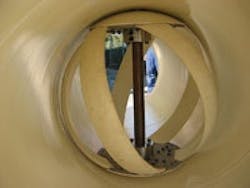Lucid Energy Dreams
Water and energy are inextricably linked. It takes a lot of energy to deliver water and it takes a lot of water to produce energy. Energy is the No. 1 cost center for municipal water utilities—drinking water and wastewater facilities spend almost $4 billion per year on energy to treat water. Today, an average of 6% of the energy consumed in the U.S. is being used to purify and deliver water; in California, that energy expenditure on water is more than 20%.
At the intersection of water and energy is a new renewable energy technology known as in-conduit or in-pipe hydropower. Lucid Energy has been designing and testing this technology since 2007. Fueled by two grants from the U.S. Department of Energy and a partnership with Northwest Pipe Co., the company has developed the LucidPipe Power System, a lift-based turbine design integrated inside a large-diameter water pipe, producing electricity from the flow of water.
The company received its first patent in May 2011; in April 2012, it announced the installation of the first commercial LucidPipe Power System in a 60-in. water pipeline at Riverside Public Utilities in California.
Driving Down Energy Costs
Driven by rising energy costs, managers of large industrial water and wastewater systems have been seeking more cost-effective, renewable sources of energy. The Neely Wastewater Reclamation Facility in Gilbert, Ariz., is leveling its energy costs through the installation of solar photovoltaic power systems above its operating recharge basins. Near Washington, D.C., the Washington Suburban Sanitary Commission (WSSC) is using wind power—approximately 65,000 MWh of electricity per year of it—to help power its operations. In 2011, wind power accounted for 28% of WSSC’s total electric consumption.
In-pipe hydropower is different from other current renewable energy sources like wind or solar in that the flow of water is predictable and constant. So it follows that these systems can produce baseload, low-cost electricity around the clock by recapturing energy that already exists in the flow of the water. The in-pipe turbine in this system harvests energy without disrupting pipeline operations by extracting excess head pressure from the system. A single LucidPipe turbine can produce up to 100 kW of zero-emissions electricity. Multiple turbines can be installed in a single pipeline to produce megawatts of electricity from a single section of pipe.
The energy produced with this system can be used to power equipment behind the meter, or get fed back into the grid. For applications involving, for example, thermoelectric plants, mining operations, paper mills and others using large amounts of water in open-loop cooling systems, the turbines can be placed near the water return outlets to capture otherwise wasted energy and help offset water pumping costs. Unlike conventional hydropower technologies, the lift-based turbine can operate in a wide range of velocities; therefore, it can be used in pipelines and effluent streams with flows as low as 3 flows per second (fps). Flows ranging from 3 to 9 fps with pressures of at least 5 to 7 psi are ideal for this system.
The Benefits of Reduced Pressure
In addition to producing electricity, the slight reduction in head pressure confers added advantages for pipeline operations. Most gravity-fed systems utilize a pressure-reducing valve system to lessen the amount of pressure in water pipelines before water is delivered. Because these turbines are placed before each valve, they help relieve pressure, which not only reduces wear and tear on valves, but also helps reduce water leakage.
This is particularly significant, as water industry experts estimate that the U.S. loses 20% to 30% of water in pipelines to leaking and evaporation—that is, water that is pumped out of the ground and then returned as a consequence of aging infrastructure. The World Bank estimates that worldwide costs from leaks in water pipelines total $14 billion annually. The U.S. Environmental Protection Agency estimated that $650 billion in water infrastructure upgrades will be needed to replace aging pipelines and satisfy new demand over the next 20 years.
That spells opportunity for Lucid Energy; its in-pipe hydropower systems can be incorporated into the miles of pipeline slated for rehabilitation and new construction, with potential to generate billions of megawatts of renewable electricity from an otherwise untapped resource.
“Investing in the nexus of water and energy is compelling and critically important, both for private industries that need to improve their economics for managing water and energy usage, as well as for municipalities and irrigation districts who need to find ways to offset the rising cost of energy,” said Gregg Semler, president and CEO of Lucid Energy. “We are very focused on the opportunity to recapture energy from an existing renewable resource. This is a smart investment for our customers that not only provides many operational benefits, but also pays for itself very quickly.”
The LucidPipe power system qualifies for the Investment Tax Credit and Production Tax Credit, as well as state incentives for renewable energy generation. The system is delivered on site in large- (from 24- to 96-in.) diameter pipe, and it can operate across a wide range of flow conditions, volumes and velocities.
The technology, which was piloted and tested at Riverside Public Utilities, Calif., is now commercially available to public utilities, agriculture irrigation districts and private industries. The company recently signed an agreement with the Portland Development Commission and the city of Portland, Ore., to partner on the development of a hydropower system within the city, and plans are underway for the in-pipe hydropower system to be deployed at San Antonio Water System in Texas.
Download: Here
